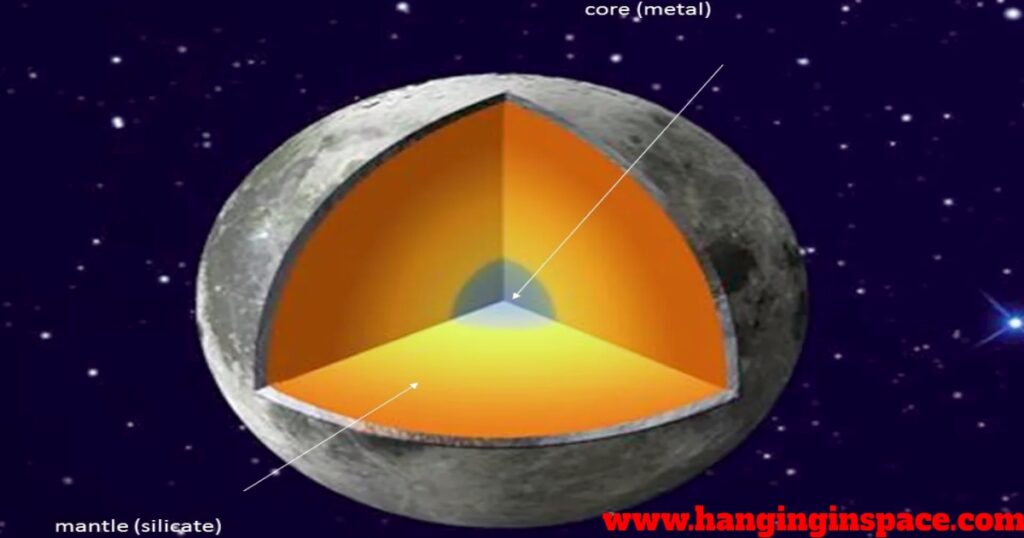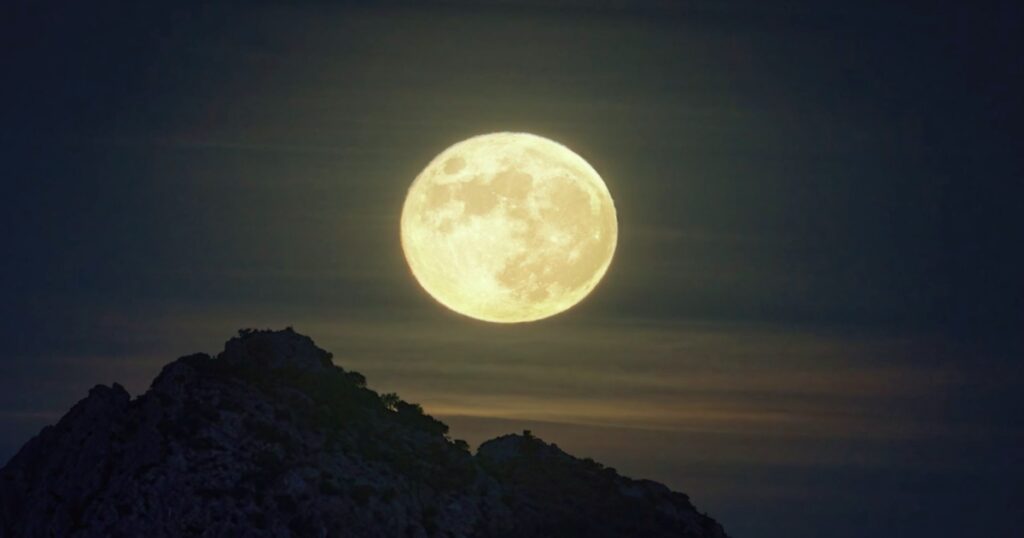The Moon is Earth’s natural satellite, a rocky world orbiting our planet Earth. It shines by reflecting sunlight and has a big impact on Earth’s tides and climate.

According to scientists, the Moon formed around 4.5 billion years ago, following a giant impact. The theory suggests a Mars-sized object slammed into early Earth, ejecting a large chunk of molten rock and debris into orbit. Over time, this debris merged under gravity’s influence, forming the Moon.
What is the Size of the Moon?
The Moon’s radius is 1,737.1 kilometers (1,079.4 miles). The Moon’s diameter is 3,474.2 kilometers (2,158.8 miles). The Moon’s circumference is 10,917.4 kilometers (6,783.5 miles).
Despite not being massive, the moon is still the fifth largest moon in our solar system.
What is the Mass and Volume of Moon?
The Moon’s mass is approximately 7.35 x 10^22 kilograms (kg). Its volume is approximately 2.2 x 10^10 cubic kilometers (km^3).
What is the Temperature of Moon?
The Moon has practically no atmosphere. It’s considered a near vacuum, with a surface pressure about a billion times thinner than Earth’s atmosphere. This lack of a protective blanket means the Moon experiences dramatic temperature swings.
On the sunlit side, temperatures can soar to a scorching 127°C (260°F), hot enough to boil water. However, when darkness falls, the lunar surface plunges to a frigid -173°C (-280°F), colder than the freezing point of carbon dioxide. This vast difference highlights the crucial role atmospheres play in regulating temperature.
What is Moon’s Average Distance from Earth & Sun?
It orbits Earth at an average distance of about 384,400 kilometers (km), while its average distance from the Sun is approximately 149.6 million kilometers (km).
How long does it take the Moon to Orbit the Earth?
The Moon takes two slightly different lengths of time to complete its journey around Earth, depending on what reference point we use:
Sidereal Month: This refers to the time it takes the Moon to complete one full orbit around Earth relative to the fixed stars. It takes approximately 27.3 days for the Moon to complete a sidereal month.
Synodic Month: This refers to the time it takes for the Moon to return to the same phase as seen from Earth (e.g., from new moon to new moon again). Due to the combined motions of the Earth and Moon around the Sun, a synodic month is slightly longer than a sidereal month, taking about 29.5 days.
So, depending on what you mean by “orbit,” it takes the Moon either 27.3 days or 29.5 days to complete its journey around Earth.
How long does it take the Moon to Spin on its Axis?
The Moon and Earth are in a special relationship called tidal locking. This means the Moon always keeps the same face pointed towards Earth.
Tidally Locked: Over billions of years, Earth’s gravity has “locked” the Moon’s rotation. The same side of the Moon is constantly facing us, while the far side remains permanently out of view from Earth.
Same Spin as Orbit: Because of this tidal locking, the time it takes the Moon to spin on its axis is exactly the same amount of time it takes to orbit Earth. This means both the spin and the orbit take 27.3 days.
Gravitational Field Strength:
On the Moon’s surface, the gravitational acceleration is approximately 1.625 meters per second squared (m/s²). This is about 16.6% of the Earth’s surface gravity, which is approximately 9.81 m/s².
Escape Velocity:
The escape velocity to leave the gravitational pull of the moon is approximately 2.38 kilometers per second (km/s).
What is the Composition of the Moon?
The moon is made up of rock, dust, ice, and trace elements:
Rock and Dust:
These make up the bulk of the Moon, with elements like oxygen, silicon, aluminum, iron, and calcium being the most abundant.
Ice:
Water ice exists in permanently shadowed craters and potentially as subsurface deposits.
Trace Elements:
Small amounts of other elements like titanium, magnesium, and volatile compounds like methane and helium are also present.
What is the Interior Structure of the Moon?
The moon’s interior structure consists of a crust, mantle, and core.

Crust:
The outermost layer, the lunar crust, is a relatively thin shell, ranging from 60 to 100 kilometers thick. This crust is primarily composed of igneous rock, formed from the solidification of molten material eons ago.
The lunar surface, heavily bombarded by meteoroids and asteroids over time, has created a layer of loose rock and dust called the regolith. This fine, gray powder covers much of the moon’s surface and is the material astronauts first walked on during the Apollo missions.
Mantle:
Beneath the crust lies the lunar mantle, the most voluminous layer, estimated to be about 1,300 kilometers thick. The composition of the mantle is believed to be similar to the crust, consisting of silicate minerals like olivine and pyroxene.
However, unlike Earth’s churning mantle, the moon’s mantle is likely solid due to its smaller size and lack of internal heat generation.
Core:
At the Moon’s heart lies a relatively small core, estimated to have a radius of around 350 kilometers. Unlike Earth’s core, which is believed to be a liquid iron outer core surrounding a solid inner core, the Moon’s core’s composition is still under debate. Some theories suggest a solid, iron-rich core, while others propose a partially molten outer core with a smaller, solid inner core.
Moon’s Surface:
The moon doesn’t have an atmosphere. It is a geologically dead world. It has no active volcanoes or plate tectonics, resulting in a landscape dominated by craters, mountains, and vast plains.
These craters are proof of the Moon’s intense past, formed by billions of years of asteroid and comet impacts. Some of the largest craters, like the lunar basin Aitken, are hundreds of kilometers wide and show the Moon’s violent history.
The Moon’s surface is also marked by towering lunar mountains, particularly along the edges of the mare, large, dark, basaltic plains. These plains were formed by ancient volcanic eruptions, where molten rock filled in giant impact basins. The lunar mare is darker than the surrounding highlands because the volcanic rock absorbs more sunlight.
Another interesting lunar feature is the lunar regolith, a layer of dust and broken rock covering the moon’s surface. This regolith is the result of constant micrometeorite bombardment, pulverizing the surface over time. The regolith is surprisingly deep in some areas, reaching tens of meters.
Moon’s Influence:
The Moon’s gravitational pull creates a bulge on both sides of Earth’s oceans, resulting in high tides. As the Earth rotates and the Moon continues its orbit, these bulges move around the planet, causing the familiar daily cycle of high and low tides. The moon’s gravity also stabilizes Earth’s tilt on its axis, contributing to a more stable climate over long periods.

Moon’s Formation:
The most widely accepted theory for the formation of the moon is the Giant Impact Hypothesis. According to this theory, the Moon formed about 4.5 billion years ago when a Mars-sized protoplanet, often referred to as “Theia,” collided with the early Earth.
The impact was so violent that it caused a portion of Earth’s mantle and crust to be ejected into space. This material eventually coalesced to form the moon.
Evidence supporting this theory includes the similarities in isotopic composition between Earth and Moon rocks, as well as computer simulations of such giant impacts. The formation of the Moon had a profound impact on Earth’s evolution, influencing its rotation, tides, and potentially even the development of life.
When and Who Discovered the Moon?
The Moon has been known since ancient times, with its presence in the night sky observed by early civilizations. However, its discovery in terms of detailed understanding and exploration has evolved over centuries.
Galileo Galilei made significant contributions to our understanding of the moon when he observed its surface through a telescope in 1609. His observations revealed mountains, craters, and other features, challenging the prevailing belief at the time that the Moon was a perfect, unblemished sphere.
Subsequent centuries saw further advancements in lunar exploration, culminating in the Apollo missions of the 20th century, which provided humans with the first opportunity to set foot on the lunar surface and greatly expanded our knowledge of Earth’s celestial companion.
Conclusion:
The Moon holds the key to unlocking the mysteries of our solar system’s formation and evolution. Studying its geology can provide insights into the early history of Earth and the violent events that shaped our solar system.
